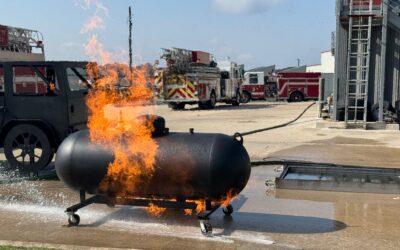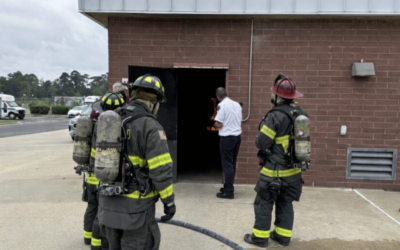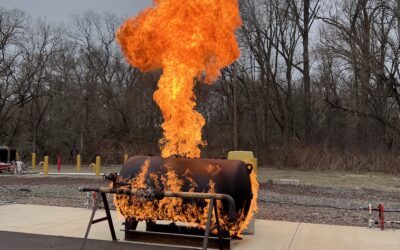How can we help you?
Search our entire website or scroll down to our FAQ for commonly asked questions. New questions are added often.
Frequently asked questions
We now have a FAQ list that we hope will help
you answer some of the more common questions.
1. What is NFPA 1402 and what is the date of the most recent revision?
NFPA 1402 is the Standard on Facilities for Fire Training and Associated Props. “NFPA 1402 provides guidance for the planning of fire service training centers, focusing on the main components necessary to accomplish general fire fighter training effectively, efficiently, and safely” (nfpa.org). The last revision was published February 2019.
2. Is NFPA 1402 a Standard or a Guide?
In 2019, the new NFPA standard was released. Previously, NFPA 1402 was a Guide. Standards spell out what kind of system and how it must work. Unlike a Guide, the main text of a Standard contains only mandatory provisions using the word “shall” to indicate requirements.
3. Describe an 'intermittent pilot' and an 'interupted pilot.'
An intermittent pilot is a pilot that burns during light-off and while the main burner is firing.
An interrupted pilot is a pilot that is ignited and burns during light-off and is automatically shut off at the end of the trial-for-ignition period of the main burner(s).
4. Please explain what 'trial for ignition period' means.
The interval of time during light-off that a combustion safeguard allows the fuel safety shutoff valve to remain open before the flame detector is required to supervise the flame.
5. What is a flame detector and a safety interlock?
A flame detector senses the presence or absence of flames. A safety interlock ensures the safe startup, operation, and shutdown of fire simulator equipment. A compliant system monitors the presence of a pilot and does not allow for the main gas valve(s) to open without a confirmed pilot.
6. What is a flame extension or flame spread and does NFPA 1402 address them?
NFPA 1402 does address flame spreads/extension fires. For exterior systems, per NFPA 1402, at least one main burner must be ignited by the pilot ignition source. Adjacent burners (such as flame spreads/extensions fires) may ignited by other main burners. For interior systems, all main burners must be ignited directly from a monitored and confirmed pilot flame.
7. What events must result in automatic fuel shut-off (for exterior props)?
Two electro-mechanical safety shutoff valves piped in series shall automatically shut-off fuel in any of the following events:
- activation of manual emergency switch
- interruption of electrical power
- activation of any interlocking safety devices
- activation of combustion safeguard
- failure of the operational controls
- activation of manual shutdown stations
8. What does operator present capability mean and why is it important?
Operator present refers to a “deadman” feature that is to be included in every prop control system per NFPA 1402. This enables a full stop on all training fires if the operator presence ceases for any reason and at any time. Systems that can be bypassed (e.g., a brick or weight on a foot pedal or a latching button on a wireless remote) are not compliant.
9. What is a NRTL and why are they important?
NRTL stands for Nationally Recognized Testing Laboratory. NFPA 1402 requires that Gas-fueled live fire training systems be listed or labeled by a third-party NRTL to ensure compliance with the requirements of the standard.
10. Where can I find a list of OSHA-approved NRTL's?
A full listing of OSHA-approved NRTL’s can be found at https://www.osha.gov/dts/otpca/nrtl/nrtllist.html.
11. Where can I find a list of NRTL's that are no longer recognized?
A list of NRTL’s that are no longer recognized can be found at https://www.osha.gov/dts/otpca/nrtl/recgterm.html.
12. What is the difference between labelled and listed?
Labeled – Equipment or materials to which has been attached a label, symbol, or other identifying mark of an organization that is acceptable to the authority having jurisdiction and concerned with product evaluation, that maintains periodic inspection of production of labeled equipment or materials, and by whose labeling the manufacturer indicates compliance with appropriate standards or performance in a specified manner.
Listed – Equipment, materials, or services included in a list published by an organization that is acceptable to the authority having jurisdiction and concerned with evaluation of products or services, that maintains periodic inspection of production of listed equipment or materials or periodic evaluation of services, and whose listing states that either the equipment, material, or service meets appropriate designated standards or has been tested and found suitable for a specified purpose.
13. Is operation and maintenance training required under the new NFPA 1402 Standard? If so, what must it include?
Operation and Maintenance Training is required for all gas-fueled fire training equipment under the new NFPA 1402 Standard. This includes exterior prop equipment. Training must cover startup, operation, and lockout/tagout procedures, as well as maintenance and calibration.
14. Is maintenance, testing, and inspection required on an on-going basis under NFPA 1402?
Yes, maintenance, testing, and inspection is required on an on-going basis, per NFPA 1402. The required frequency is annually at a minimum.
1. What power source is required to operate Symtech Outdoor Fire Simulators?
Outdoor Fire Simulators require a 110V GFIC outlet or similar power source such as a portable generator.
2. What thermal output can I expect from Symtech exterior props?
Symtech exterior props have both vapor and liquid propane feeds for two-stage fires. Vapor fires are rated for 4.5 mmbtu/hr. Liquid fires are rated for over 60 mmbtu/hr.
3. What size propane tank do I need for exterior fires? What are important considerations?
Propane tank sizing is dependent on a variety of factors including likely fuel type (vapor vs. liquid state) for most exercises, re-fill frequency, and local climate. It also depends on the number of mockups and fires your agency plans to use at one time. For a single fire using vapor fires, a manifolded set of 100 lb. cylinders may be adequate. For larger fire grounds with multiple fires or any scenarios where liquid is used frequently, we recommend a min. 500-gallon propane supply tank (while 1,000 gallons is ideal in terms of vapor recovery, re-fill frequency and overall performance). Local climate is also a factor. Cold temperatures result in slower vapor recovery in propane tanks and my necessitate the use of a larger tank or vaporizer.
4. Do I need underground fuel lines? Are special propane tank fittings required?
For portable props, underground fuel lines are not required. Flexible liquid propane rated hoses are supplied by Symtech. Propane tanks should be installed with both a vapor and liquid feed if desired and should include 1.5″ POL x ACME male fittings.
Underground fuel lines may be put in place for fixed (or even portable) props in order to product a cleaner training site area. Symtech can help coordinate the infrastructure requirements of your project including both fuel and electrical requirements.
5. Do I need a concrete pad to set the training props on? Is pavement or another surface suitable?
A hard, compacted surface is all that is needed to set our training props on. Our props are used frequently on asphalt, parking lots, and hard surfaces such as a field or graveled area. A concrete pad is ideal, but is not necessary.
6. What materials are used for Fire Prop construction? Are options available?
All Symtech mockups are constructed of 1/4″ (6mm) thick steel. All burner elements are constructed of high quality stainless steel. All components are approved and designed for the environment.
Optionally, mockups can be upgrades to stainless steel or Cor-Ten (ASTM A588) weathering steel.
7. Are there limitations to how many fires can I run simultaneously?
Symtech’s Wireless Controls allow for operation of up to eight fires in a single prop at one time. Our multi-control systems allow operators to run multiple props at one time and up to 12 fires simultaneously.
8. What is the difference between the Fire Simulator ST and Fire Simulator ST-Pro?
The Fire Simulator ST lineup relies on our Pilot Module ST (portable pilot igniter) for ignition of main fires. Some mockups also require the use of the Burn Pan ST. ST props provide a single fire that in some cases is relocatable for different training scenarios and fires (e.g., Car Fire Simulator ST).
The Fire Simulator ST-Pro provides fully integrated ignition systems and never relies on a separate ignition module or burn pan.
In both cases, fires are two-stage:
- (1) first stage vapor
- (2) second stage liquid
9. What should I consider when selecting between the Fire Simulator ST and Fire Simulator ST-Pro models?
This decision is typically driven by training needs and budget. The Fire Simulator ST is more economical with a lower cost to begin building your training prop arsenal. The Fire Simulator ST-Pro provides more advanced training exercises with progressive fire attack, enhanced features like simulated shut-offs, and fuel (water) leak effects where applicable.
10. Is operation and maintenance training included with Fire Simulator ST and ST-Pro purchases or is it additional?
Virtual operation and maintenance training is included with every Fire Simulator ST and Fire Simulator ST-Pro purchase. This includes many hands-on elements. Optionally, in-person courses are available at an additional charge.
1. What types of Class "A" fire training units does Symtech offer?
Symtech offers Containerized and Mobile Class “A” Fire Suppression Units, Flashover Trainers, Fire Behavior Labs, and Realistic Class “A” Burn Prop Mockups.
2. Does NFPA recognize Class "A" fixed and mobile fire training containers?
Yes, Class “A” fixed and mobile containers are covered in NFPA 1402: Standard on Facilities for Fire Training and Associated Props.
3. Does Symtech modify existing containers or supply new ones?
Symtech can modify and retrofit existing containers or we can furnish new ones. That said, even with increased container costs, the majority of container facility costs lie in engineering and fabrication work when furnishing a well-built facility. Used containers save a small percentage of overall project costs, yet they reduce the longevity of the facility.
4. When furnishing new containers what type does Symtech supply?
We recommend standard height (8.0-ft tall) or high-cube (9.5-ft tall) one-way, ISO containers. Certain high cube sizes may have limited availability depending on time of order.
5. What type of exterior finish is used?
Symtech uses primer followed by a marine and industrial grade paint (choice of color). Smooth exterior cladding is available at an additional cost. Alternate finishes are available upon request.
6. What are the differences between Symtech ST and ST-PRO construction?
ST follows low-cost industry standards for modified containers. This includes diamond plate flooring over marine grade plywood, diamond plate roofs, and high temp interior finish. ST-PRO units include non-skid steel flooring, bar grating roof decks, and a 2,300° F Thermal Lining System.
7. What are important consideration for a container build?
When comparing options and vendors the most important considerations are new vs. used containers, framing and flashing methods, thermal protection, flooring construction, roof/decking construction, and experience with gas fired simulators (if included).
8. Can Symtech furnish a combination fixed or mobile facility with both Class "A" and Gas Fired Props?
Yes, our gas detection equipment and live fire training system design methodology makes combination facilities a possibility.
9. Does Symtech provide the concrete pad or foundation design for fixed container facilities?
We provide concrete pad and/or footing/foundation layout drawings. We can provide engineered drawings on request. We do not handle concrete pad (or other utility construction) unless otherwise specified.
10. Are Symtech designs expandable?
Yes, Symtech designs are expandable by nature. We take pride in taking a master planning approach to any facility to ensure future needs are considered in the design whenever possible.
1. Before you get started
Tincidunt elit magnis nulla facilisis. Dolor sagittis maecenas. Sapien nunc amet ultrices, dolores sit ipsum velit purus aliquet, massa fringilla leo orci.
2. Versatile hosting plans and pricing
Tincidunt elit magnis nulla facilisis. Dolor sagittis maecenas. Sapien nunc amet ultrices, dolores sit ipsum velit purus aliquet, massa fringilla leo orci.
3. Compatibility with premium plugins
Tincidunt elit magnis nulla facilisis. Dolor sagittis maecenas. Sapien nunc amet ultrices, dolores sit ipsum velit purus aliquet, massa fringilla leo orci.
4. Install theme demo contents
Tincidunt elit magnis nulla facilisis. Dolor sagittis maecenas. Sapien nunc amet ultrices, dolores sit ipsum velit purus aliquet, massa fringilla leo orci.
5. Layout and design options
Tincidunt elit magnis nulla facilisis. Dolor sagittis maecenas. Sapien nunc amet ultrices, dolores sit ipsum velit purus aliquet, massa fringilla leo orci.
6. Translation and localization services
Tincidunt elit magnis nulla facilisis. Dolor sagittis maecenas. Sapien nunc amet ultrices, dolores sit ipsum velit purus aliquet, massa fringilla leo orci.
7. Connecting social media channels
Tincidunt elit magnis nulla facilisis. Dolor sagittis maecenas. Sapien nunc amet ultrices, dolores sit ipsum velit purus aliquet, massa fringilla leo orci.
8. Optimize theme speed & performance
Tincidunt elit magnis nulla facilisis. Dolor sagittis maecenas. Sapien nunc amet ultrices, dolores sit ipsum velit purus aliquet, massa fringilla leo orci.
9. Live chat support
Tincidunt elit magnis nulla facilisis. Dolor sagittis maecenas. Sapien nunc amet ultrices, dolores sit ipsum velit purus aliquet, massa fringilla leo orci.
10. Developer documentation
Tincidunt elit magnis nulla facilisis. Dolor sagittis maecenas. Sapien nunc amet ultrices, dolores sit ipsum velit purus aliquet, massa fringilla leo orci.
1. Before you get started
Tincidunt elit magnis nulla facilisis. Dolor sagittis maecenas. Sapien nunc amet ultrices, dolores sit ipsum velit purus aliquet, massa fringilla leo orci.
2. Versatile hosting plans and pricing
Tincidunt elit magnis nulla facilisis. Dolor sagittis maecenas. Sapien nunc amet ultrices, dolores sit ipsum velit purus aliquet, massa fringilla leo orci.
3. Compatibility with premium plugins
Tincidunt elit magnis nulla facilisis. Dolor sagittis maecenas. Sapien nunc amet ultrices, dolores sit ipsum velit purus aliquet, massa fringilla leo orci.
4. Install theme demo contents
Tincidunt elit magnis nulla facilisis. Dolor sagittis maecenas. Sapien nunc amet ultrices, dolores sit ipsum velit purus aliquet, massa fringilla leo orci.
5. Layout and design options
Tincidunt elit magnis nulla facilisis. Dolor sagittis maecenas. Sapien nunc amet ultrices, dolores sit ipsum velit purus aliquet, massa fringilla leo orci.
6. Translation and localization services
Tincidunt elit magnis nulla facilisis. Dolor sagittis maecenas. Sapien nunc amet ultrices, dolores sit ipsum velit purus aliquet, massa fringilla leo orci.
7. Connecting social media channels
Tincidunt elit magnis nulla facilisis. Dolor sagittis maecenas. Sapien nunc amet ultrices, dolores sit ipsum velit purus aliquet, massa fringilla leo orci.
8. Optimize theme speed & performance
Tincidunt elit magnis nulla facilisis. Dolor sagittis maecenas. Sapien nunc amet ultrices, dolores sit ipsum velit purus aliquet, massa fringilla leo orci.
9. Live chat support
Tincidunt elit magnis nulla facilisis. Dolor sagittis maecenas. Sapien nunc amet ultrices, dolores sit ipsum velit purus aliquet, massa fringilla leo orci.
10. Developer documentation
Tincidunt elit magnis nulla facilisis. Dolor sagittis maecenas. Sapien nunc amet ultrices, dolores sit ipsum velit purus aliquet, massa fringilla leo orci.


